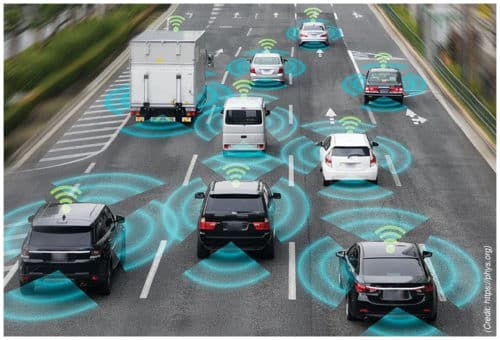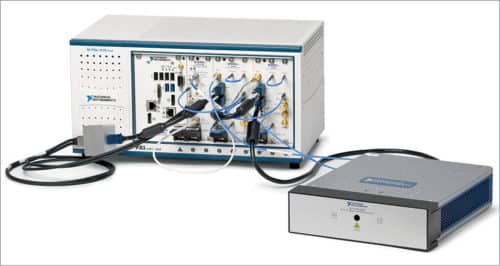In spite of improving technologies, vehicular ad hoc networks (VANETs) for effective data sharing through reliable wireless communication between vehicles remain a topic of discussion even now.
Intelligent connectivity is transforming every sphere of our lives, including transportation and mobility networks that connect places worldwide. New-generation transportation and mobility systems require advanced designs, intelligent and sustainable engineering, and collaboration in multiple realms.
Rise of such technologies as the Internet of Things (IoT), 5G, artificial intelligence (AI) and machine learning (ML) is making disruptive connectivity services possible. In fact, in recent years these have become more common than most people realise. For example, we all use GPS for navigation, which suggests an alternative route in real time after receiving information on traffic ahead. Other popular examples include Android Auto, Apple CarPlay and Amazon Alexa available on smartphones to integrate data and improve connectivity.
According to a report from MarketWatch, the global connected passenger car market is expected to reach US$ 75.67 billion by 2023, expanding at a CAGR of eleven per cent, while the global connected truck market is expected to reach US$ 46.84 billion expanding at a CAGR of thirteen per cent in the forecast period from 2018 to 2023. In this article, we focus on connected vehicles (CVs), the key to the next generation of intelligent transportation systems.

Connected and autonomous vehicles
CVs use wireless communication technologies (like short-range radio signals) or devices that allow them to communicate bi-directionally with everything (V2X) inside as well as outside the vehicle including the driver, other vehicles (V2V), pedestrians (V2P) and roadside infrastructure (V2I). Data sharing with other systems and then analysis on the cloud (V2C) enables efficient navigation, security, infotainment, remote diagnostics and payment features, among others.
With AI-enabled services for human-to-vehicle interactions, vehicles become truly smart. One such example is BMW’s intelligent personal assistant (IPA), an infotainment system that can be started with the wake-up words ‘Hey BMW.’ Using ML, the assistant also improves its customised recommendations for the driver.
Unlike a CV where the final decision is made by the driver, a fully autonomous vehicle (AV), popularly known as self-driving vehicle, navigates independently on the road without a human driver and has features like self-parking and auto collision avoidance. But some form of connectivity via devices like sensors, such as light detection and ranging (LIDAR) and radio detection and ranging (RADAR), is necessary to provide real-time information about latest changes on the route and detect operational issues, thereby ensuring reliability.
Most commercial applications still prefer a human operator to handle difficult situations in AVs. Yet, cases like the recent arrest of ex-Waymo driver for deliberately crashing Waymo vehicle into his car and the fatal accident caused by Uber’s self-driving car in 2018 show that a lot of work needs to be done in this sector. Many leading automotive (for example, Volkswagen and Toyota) and ICT manufacturers, academia and governments are working in collaboration to make commercial AVs a reality.
Future of smart cities
Intelligent transportation and mobility systems can tackle some of the biggest challenges that make them not a choice for an enhanced consumer experience but a necessity for smart cities. For instance, Toyota Mobility Foundation (TMF) recently entered into an agreement with Malaysia Digital Economy Corp. (MDEC) to launch City Architecture for Tomorrow Challenge (CATCH). The challenge, which began with an event in Kuala Lumpur in February, is aimed to attract innovative solutions from all over the world and will last eight months.
Saving lives. According to ‘Pune-Mumbai Expressway Road Accident Study 2018’ by JP Research India (JPRI), human errors (not wearing seatbelts, driver fatigue and speeding) and infrastructural flaws were the main reasons for accidents on Pune-Mumbai expressway.
Instead of finding remedies after crashes, smart connectivity improves vehicle safety and efficiency through continuous monitoring of surroundings for situational awareness. It looks out for even those problems that the driver cannot see, like cars in the driver’s blind side or change in a traffic light ahead [unlike radar that depends on line-of-sight (LOS) communication and is more expensive].
Due to onboard advanced warning and driving assistance systems (ADASs), drivers have to focus on fewer tasks besides getting enough time and tools to act immediately in dangerous situations. Hence, there is a lower risk of accidents. For instance, in TECO Line Streetcar System, an electric trolley service in Florida, drivers are alerted in emergencies. This is highly useful in cases where continuous driving can lead to lapses in attention.
Low carbon mobility. Transportation is a major contributor to greenhouse gas (GHG) emissions with traffic caused by large vehicle population resulting in a huge amount of fuel wastage. CVs can monitor vehicle type and emissions, and help make eco-friendly decisions like rescheduling trips for congestion reduction and use of public (high occupancy, low emission vehicles) or green (ride-sharing, electric mobility) transportation options. Auto Expo 2020 saw the first-ever electric sports vehicle Marvel X by MG Motor with an electric powertrain, integrated Internet connectivity and autonomous capabilities.
Transportation managers and agencies can also plan future deployments more easily with the past as well as available real-time road conditions data. Commute times can get reduced significantly as time taken to travel on different routes can be estimated in real time, enabling better traffic flow management. Other benefits from analysis of data generated by sensors embedded in infrastructure include elimination of excessive starts and stops, easy crossing at intersection for pedestrians, faster search for available parking spaces and so on.
Platforms and prototypes
CVs data consists of a large amount of sensor and usage data, such as vehicle location, velocity, environment status, engine RPM, fuel level and so on. The IoT is making the Internet of Vehicles (IoV) possible. This could be seen at Auto Expo 2020 where telecom major Reliance Jio showcased its connected vehicle solutions to aid users get insights into vehicle performance and other metrics. Solutions include scalable components like hardware, connectivity and platform.
Information collection needs to be anonymous with no personal identification of owners or vehicles. The platform must be able to receive, process and store data reliably for later processing and analytics. Google Cloud Platform (GCP) is a computing platform that benefits from Google’s security model for building and operating CV platforms. As data volume increases, ML models can be developed to algorithmically deduce conclusions based on past information. For instance, TensorFlow is a popular open source ML framework that can be used for such applications.
To connect multiple devices to any platform, the challenge is to authenticate, configure, monitor and manage software. Software flaws can make vehicles vulnerable to attacks, and so they must be detected and dealt with before deployment.
Prototypes for CVs and AVs built using modular hardware and flexible software solutions are an economical option for proper development and validation. For instance, launched by National Instruments (NI) in 2017, vehicle radar test system (VRTS) is built on a flexible software and modular hardware platform (refer figure on previous page). The system combines mmWave technology, a PXI vector signal transceiver (VST) and application-specific software. PXI VST is a design platform for RF automated test and measurement.
With addition of a software development environment like LabVIEW, customised prototyping and testing of solutions become simpler. For example, simulations of dynamic obstacles like a vehicle changing lanes in different road conditions are possible.
Reliability in stringent conditions and low latency in network are critical requirements in connected systems. Accurate modelling of the propagation environment should be done for vehicle-to-vehicle (V2V) communication systems. Testing and verification of dedicated short-range V2X communication are necessary to ensure that it will work persistently in all possible scenarios and is safe from outside interference during the entire lifecycle, even in a highly dense environment.
Vehicle devices can securely communicate with each other using industry-standard protocols like Message Queuing Telemetry Transport (MQTT). To guarantee accurate transmission and reception of data packets, the focus is on time division multiple access (TDMA). Operations need to be done in the background such that alerts are sent only in case of dangers, otherwise, these might divert attention of the driver.
Tata Communications, a telecommunications company, is working with Microsoft to enable automotive manufacturers to offer innovative connected car applications to their customers. The company’s MOVE platform, when integrated with Microsoft’s CV Platform, will allow manufacturers to have encrypted vehicle-to-cloud (V2C) connectivity in vehicles.

The road ahead
Although intelligent connectivity will enable the services customers want, cybersecurity will play a key role in determining acceptance. For this, proper implementation of certification policies, licensing rules and standards is required. Understanding the need for a comprehensive data protection law, Personal Data Protection Bill was introduced in the Indian Parliament by Minister of Electronics and Information Technology in December 2019.
A recent study by Deloitte shows that as one of the largest auto markets, India has the highest rate of customers in favour of vehicle connectivity, but it is also the first when it comes to data security concerns.
Blockchain can be beneficial in this case as it boosts data security by decreasing risk of data manipulation. Tamper-proof records along with blockchain-enabled smart contracts will improve consumer trust and facilitate easier payments.
In spite of improving technologies, vehicular ad hoc networks (VANETs) for effective data sharing through reliable wireless communication between vehicles remain a topic of discussion even now. Inbuilt Internet connectivity through the 4G-LTE cellular network is already present in services like Audi Connect. With adoption of 5G communication technology and implementation of proper standards worldwide, it is hoped that higher speed will enable better connectivity in autonomous driving and connected ecosystems. For example, Ford is testing a fully autonomous 5G-connected vehicle in the US, intending to have it in operation by 2021.
Wi-Fi is another promising and inexpensive option for pervasive access services. But the problem is in meeting the requirements for serving high-speed vehicles in contrast to the usual stationary or slow-moving users.
Also, people are less willing to pay extra for services they do not consider necessary, such as infotainment systems (like interactive gaming that requires large bandwidth), currently. However, as technical challenges are solved and number of such vehicles rises, increasing demand for such products and services will be seen. Competition is bound to increase, which will result in lower costs. This will enable comprehensive connectivity to be a standard in the future, and not just be limited to luxury vehicles.





